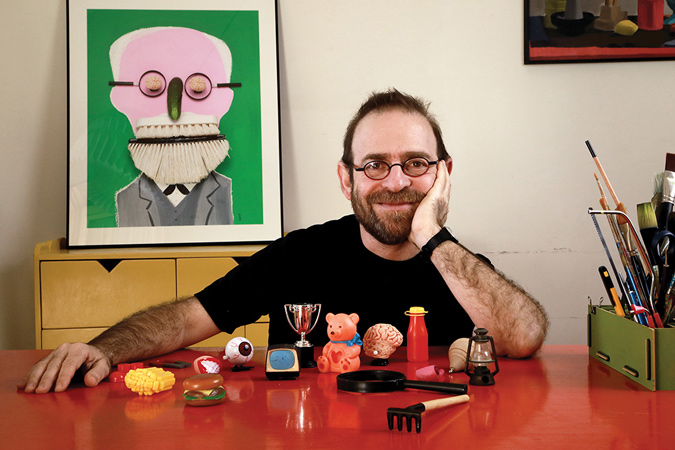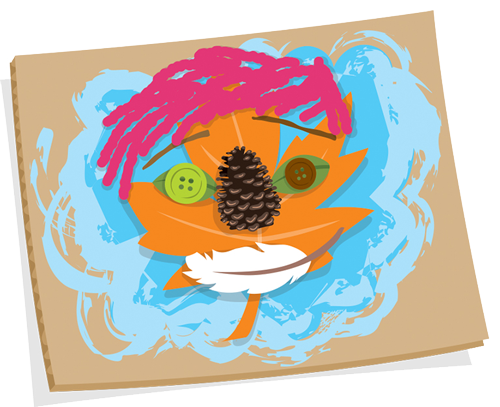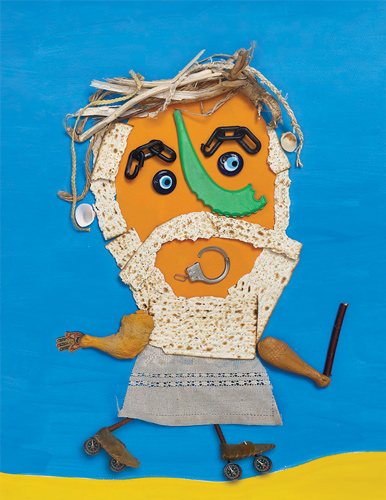Hanoch Piven has turned that answer into art. In his forthcoming children's book, that means a postcard body for Abraham and a whistle nose for Esther.
By Naomi Shulman, Content Officer
This story appeared in the December 2022 issue of PROOF, a PJ Library magazine.

Born in Uruguay and raised in Israel, artist Hanoch Piven says good ideas for portraits start when he simply moves the objects around and plays. Photo by Toni Ricart
Hanoch Piven's art likely looks familiar. His portraits, crafted with everyday objects — think light bulbs for noses, seashells for eyes, and matzah for beards — have been featured in the Atlantic, the New Yorker, and Esquire, among many other publications. He's gained such fame that people often give him bags of junk for his art. “They are proud when they see things show up in my portraits,” says 59-year-old Piven.
But the Israeli international artist recently took on a project outside his wheelhouse: illustrating Bible stories. Dream Big, Laugh Often and Other Advice from the Bible, a collaboration with Torah scholar Shira Hecht-Koller, is being published by Farrar, Straus and Giroux in early 2023. It'll land in the mailboxes of 8-year-old PJ Library subscribers shortly thereafter and will be available online and in bookstores. PROOF caught up with Piven to talk about his art and how he went from portraits of Prince and Iggy Pop to bringing Eve and Elijah to life.
Hands on!
Every portrait in Dream Big, Laugh Often and Other Advice from the Bible is made with everyday objects that one might find around the house. Some of those objects are clues into a character's personality or story. Why not create a self-portrait using objects around your home?
 Illustration by Adam Komosinski
Illustration by Adam Komosinski
Supplies
-
Small random items (buttons, beads, scraps of paper, snippets of string or fabric, seashells, twigs, magazine clippings, pieces from board games, dried beans or rice — anything goes!)
-
Glue (optional)
-
Cardboard or heavy construction paper (optional)
-
Your imagination
Directions
Hunt around your house for small random items (like the ones in the list above). Place your collection in a pile on a table, then arrange the objects into a picture that reflects how you see yourself.
If none of the objects in your portrait are things that will be needed again (check with a grownup!), consider gluing your artwork down onto a piece of cardboard or heavy construction paper.
Naomi Shulman: When did you first become interested in creating art?
Hanoch Piven: I was the artist of the class in the Jewish school I went to in Uruguay, where I was born. At age 25, I went to New York [to the School of Visual Arts], and when I started drawing again, I realized I was limited technically. So I started to look for other ways of doing art. Lots of Jewish Eastern European artists, such as Saul Steinberg of the New Yorker, were doing collage. I see the collage method as a process of discovery because you're dependent on what you find. When you react to what you see, you need to observe, be present, pay attention, look for happy accidents. And you need to accept that you don't know what you're doing until something happens. There are a lot of life lessons in collage.
NS: How did your partnership with your coauthor Shira come about?
HP: In Yiddish, the word is beshert.
A few years ago, I was invited to Camp Moshava in the Poconos [in Pennsylvania] as an artist in residence. After I gave a talk, Shira came to me and said she'd love it if I'd create a couple of illustrations of Bible characters. We met a couple weeks later, and I suggested combining some of the illustrations into a book. Shira then put me in touch with PJ Library. Two or three years later, when we were getting ready to show the book to publishers, Joy Peskin, an editor with Farrar, Straus and Giroux (now the book's publisher), asked, “Have you ever done books for children?” It's just like collage: If you allow yourself to be open to happy accidents, they will come.
 Meet Moses from Dream Big, Laugh Often and Other Advice from the Bible, Hanoch Piven's new book with coauthor Shira Hecht-Koller. Image copyright © 2023 by Hanoch Piven
Meet Moses from Dream Big, Laugh Often and Other Advice from the Bible, Hanoch Piven's new book with coauthor Shira Hecht-Koller. Image copyright © 2023 by Hanoch Piven
NS: What was your relationship with these biblical characters before you started working on this book, and how has it changed?
HP: My life is very secular. But after learning about the stories for this book, I've come to love them so much. I'm a searcher; I move from country to country. When I read the story of Abraham, how can I not think the writer knows something about my own spirit? Shira and I understood that we needed to find one educational value to take from each story. With Eve, it was to be curious. Ruth was about finding your people. Looking at these characters from a human point of view is a good tool for bringing these stories closer to kids. Sometimes kids may have tantrums like Jonah and might need a time-out, and what better time-out could there be than three days in a fish's belly?
NS: I bet many children (and grownups) will be inspired to re-create your art. Where should they start?
HP: Get a basket and go around your house and look at the things in a new way. Look at everything in the junk drawer and the recycling bin as potential for creativity. If you want to do a self-portrait [see sidebar], don't worry about creating a likeness. It's more about telling a story about you. And then it's about starting to combine things. You realize the marble could be a great eye, or the tape dispenser could be a wonderful nose or mouth. If it's good, keep going! If it's not, change direction. Allow yourself to be in this wonderful space of noncommittal exploration.